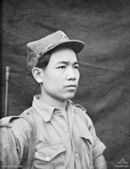- Malayan Races Liberation Army
-
Malayan Races Liberation Army Participant in the Malayan Emergency 
Portrait of an MRLA soldier (circa 1960)Active 1948-1960 Leaders Chin Peng Headquarters Various parts of the Malayan jungle Area of
operationsVarious areas of the Malayan jungle Strength 13,000 soldiers Originated as Malayan People's Anti-Japanese Army Opponents United Kingdom
Australia
New Zealand
Federation of Malaysia
Rhodesia
FijiBattles/wars Malayan Emergency The Malayan Races Liberation Army (MRLA) was the name given by British security forces to a combatant in the Malayan Emergency, an insurrection and guerrilla war against the British and Malayan administration from 1948-1960 in what is now Malaysia.
Malayan Races Liberation Army is a translation from the Chinese 马来亚民族解放军 where 民族 means "nationality" in the ethnic sense. The organization's leader Chin Peng has called this a mistranslation and corrected it to Malayan National Liberation Army (MNLA).[1][2] The name of the MNLA in Malay (Malay: Tentera Pembebasan Rakyat Malaya) could also be translated as the Malayan People's Liberation Army[3] although extant records show that the title Tentera Pembebasan Nasional Malaya or MNLA became the normal self-identity by the 1970s.[4] It was a guerrilla force created by the Malayan Communist Party and, to some extent, led and dominated by overseas Chinese communists.
Founding
The MNLA was a successor of the Malayan People's Anti-Japanese Army (MPAJA), another guerrilla force which the British had secretly trained and equipped with arms during World War II in the fight against the Japanese Occupation. The Communist Party, which had been banned in the pre-war years, was thereafter granted legal recognition by the British after the war as a reward for its wartime effort, but had secretly kept some of the MPAJA's weapons for future use.
The MCP used violence to support its union organisation, and the British used restrictions, including banishing key communist leaders not born locally, to restrict the MCP. This mutual antagonism climaxed with an armed revolt in 1948, which resulted in the declaration of the state of emergency in June 1948.
Defeated in the first Malayan emergency (1948-1960) in the Malayan jungles, and outwitted in Singapore politics by nationalist politician Lee Kuan Yew, by the mid-1960s it was fragmented. A small group of insurgents continued to operate from the Malaysian-Thailand border, until they signed a peace agreement with the Thai and Malaysian Governments in December 1989.
This allowed some of the remaining MCP members to settle in 'Peace Villages' in southern Thailand, others to return to Malaysia. No agreement was signed with Singapore, and Secretary-General Chin Peng (in office 1947 to present) has subsequently been denied the right to return to Malaysia.
References
- ^ Chin, Peng (2003), Alias Chin Peng : My Side of History : Recollections of a Revolutionary Leader, Singapore: Media Masters, ISBN 9810486936
- ^ CC, Chin; Hack, Karl, eds. (2005), Dialogues with Chin Peng : New light on the Malayan Communist Party, Singapore: Singapore Univ. Press, ISBN 9971692872
- ^ Abdullah, C.D (1998), Perang Anti-British dan Perdamaian, Hong Kong: Nan Dao, ISBN 9628533126
- ^ Kenang2an Sejarah: 25 Tahun Mulia Rejimen 10 TPNM, Underground: Pejabat "KEBENARAN", 1974
Categories:- Communism in Malaysia
- Military history of Malaysia
- Rebel militia groups
- Malayan Emergency
- Military wings of political parties
- Militias in Asia
Wikimedia Foundation. 2010.
